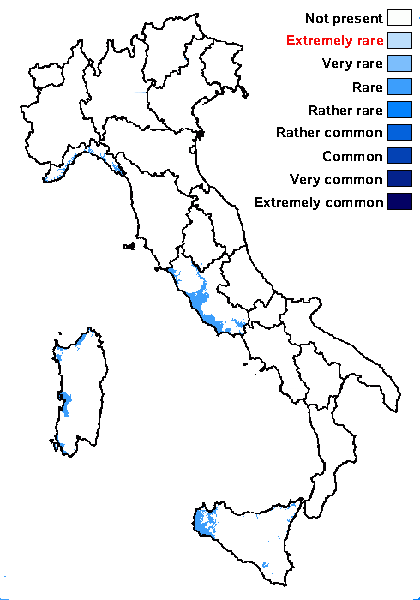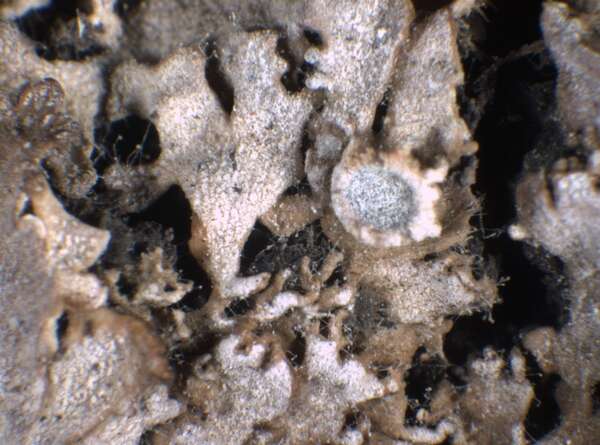Physconia grisea subsp. algeriensis (Flagey) Poelt
Nova Hedwigia, 12: 119, 1966. Basionym: Physcia farrea var. pulverulenta f. algeriensis Flagey - Cat. Lich. Alg.: 17, 1896.
Synonyms: Physcia algeriensis (Flagey) M. Choisy; Physcia grisea var. algeriensis (Flagey) J. Steiner
Distribution: N - Lig. C - Umb (Ravera & Ciotti 2015), Laz, Sar (Zedda 2002, Rizzi & al. 2011, Giordani & al. 2013, Di Nuzzo & al. 2022). S - Si (Brackel 2008b).
Description: Thallus foliose, heteromerous, dorsiventral, narrow-lobed, forming 5-6 cm wide rosettes. Lobes (1-)2-3 mm wide, radiating and partly overlapping, markedly and coarsely white-pruinose, flat to irregularly concave, often lobulate but never phyllidiate. Lower surface whitish, with simple to forked, pale rhizines. Upper cortex paraplectenchymatous; medulla white; lower cortex prosoplectenchymatous, with hyphae oriented parallel to the long axis of lobes. Apothecia frequent, lecanorine, with a pruinose disc and a smooth thalline margin. Epithecium brown; hymenium and hypothecium colourless; paraphyses slender, simple or forked in upper part, the apical cells clavate, with a thin, dark brown cap. Asci 8-spored, clavate, the K/I+ blue tholus penetrated by a faintly amyloid apical cushion with parallel or diverging flanks, the wall K/I-, surrounded by a K/I+ blue outer layer, Lecanora-type. Ascospores 1-septate, brown, ellipsoid, 26-34 x 13-17 µm, thickened at septum but not at apices, Physconia-type. Pycnidia black, immersed. Conidia 4-7 x c. 1 µm. Photobiont chlorococcoid. Spot tests: cortex and medulla K-, C-, KC-, P-. Chemistry: not known, perhaps without lichen substances. Note: this mainly Mediterranean taxon, which is both saxicolous and epiphytic, is worthy of further investigation: it could prove to be the primary, sexually reproducing species of P. grisea. Very rare in Tyrrhenian Italy.
Growth form: Foliose, narrow lobed
Substrata: bark and rocks
Photobiont: green algae other than Trentepohlia
Reproductive strategy: mainly sexual
Commonnes-rarity: (info)
Alpine belt: absent
Subalpine belt: absent
Oromediterranean belt: absent
Montane belt: absent
Submediterranean belt: absent
Padanian area: absent
Humid submediterranean belt: absent
Humid mediterranean belt: rare
Dry mediterranean belt: absent

Predictive model
Growth form: Foliose, narrow lobed
Substrata: bark and rocks
Photobiont: green algae other than Trentepohlia
Reproductive strategy: mainly sexual
Commonnes-rarity: (info)
Alpine belt: absent
Subalpine belt: absent
Oromediterranean belt: absent
Montane belt: absent
Submediterranean belt: absent
Padanian area: absent
Humid submediterranean belt: absent
Humid mediterranean belt: rare
Dry mediterranean belt: absent

Predictive model
 INDEX FUNGORUM
INDEX FUNGORUM
 GBIF
GBIF



